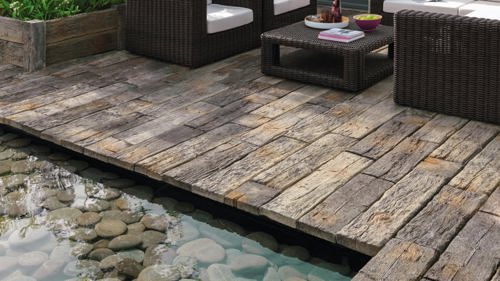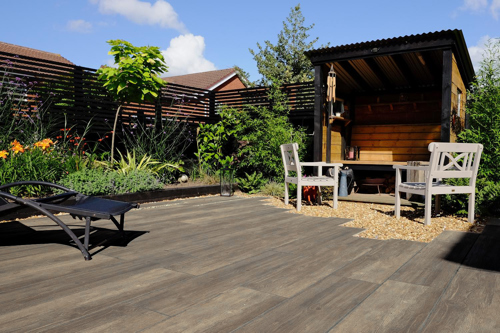Pros and cons of decking
Pros of decking
-
Aesthetic appeal: Decking's organic appearance can add a natural, rustic charm and welcoming feel to traditional gardens.
-
Quick installation: Decking is generally more straightforward and quicker to install than paving, especially if you're planning to install it yourself. This makes it a popular choice for DIY enthusiasts.
-
Cost-effective: In many cases, the upfront costs of decking are generally lower than paving.
Cons of decking
-
Fewer design opportunities: Decking offers less opportunity for creative garden designs than paving.
-
High maintenance: Timber decking requires regular maintenance to protect it from the elements.
-
Slippery when wet: Decking can become slippery in damp conditions and pose a safety risk.
-
Less durable: Decking, particularly timber, tends to have a shorter lifespan than paving and may need to be replaced sooner or more frequently.
Types of decking
Decking is an elevated structure typically constructed from planks of timber or other types of wood. It is usually raised slightly above ground level and supported by a framework of beams and joists.
Decking can be made from various materials, with timber and composite being the most common. Timber decking is often made from softwoods like pine or hardwoods such as oak.
Meanwhile, composite decking is made from a mixture of wood fibres and plastic, providing a low-maintenance alternative that mimics the appearance of wood.
Pros and cons of paving
Pros of paving
-
Durability: with the odd maintenance, Ppaving is highly durable and capable of withstanding the test of time with minimal wear and tear.
-
Low maintenance: Once installed, paving requires very little maintenance compared to decking, saving you time and effort in the long run.
-
Safety: Paving is generally less slippery, and non-slip options are available, making it a safer choice for areas prone to wet weather.
-
Adds value: Paved garden areas are shown to increase the market value of properties, making paving a smart investment.
Cons of paving
-
Higher initial cost: Paving typically costs more per square metre than decking, and installation costs are higher.
-
Installation time: Paving installation is more time-consuming, and a professional installer is usually recommended.
Types of Paving
Paving is ideal for creating durable, low-maintenance areas that can withstand heavy foot traffic and the elements, making it a favourite for patios, paths, and driveways.
Many types of paving are available to suit different tastes and budgets. Natural stone is a popular choice, with options like sandstone, slate, or limestone supplied in various tones and styles. Concrete slabs and porcelain paving are also commonly used to pave gardens and driveways, and although manufactured, they can come in designs that can mimic natural stone or lean into that contemporary feel.
Comparing decking and paving
Now that you're familiar with the basics of each flooring type, let's compare decking and paving on some key features to see how each measures up.
As you learn about the characteristics of decking and paving, remember to honour your personal preferences. Each garden is different, so whilst some homeowners favour appearance overall, some may sacrifice aesthetics for durability or safety.
Have a think about your priorities and keep them in mind as you read our expert insights.
Aesthetics
When it comes to visual appeal, the choice between decking and paving largely depends on the style you're aiming for. While decking offers a rustic, natural look, paving provides a sleek and modern finish.
Decking's organic appearance blends seamlessly with gardens full of greenery and works well for creating cosy, intimate spaces that feel like an extension of your home's interior. Its natural look makes decking an excellent choice for traditional cottage gardens and Scandinavian gardens.
On the other hand, paving offers a sleek and polished finish that thrives in modern garden designs. Bold colours and materials like slate or porcelain are perfect for a contemporary space.
However, with various materials, colours, and finishes available, paving is versatile enough to complement any garden. Cobblestone makes for a cosier look, and wood-effect paving can replicate the appearance of decking while retaining the practicality of paving.
Whilst decking offers limited design opportunities, there are many creative ways to design a patio. Check out some of our inspirational guides for ideas:
If you're torn between decking and paving for aesthetic reasons, consider combining both materials to create distinct zones within your garden. A cosy, furnished decking area for lounging and a patio for dining and entertaining could be the solution that provides the best of both worlds.
Durability and maintenance
Durability is key when choosing between decking and paving. Understanding the lifespan and upkeep requirements of each option can prevent future issues.
Timber decking can last many years with proper care but is prone to weathering, rot, and insect damage. Regular maintenance, including pressure washing, cleaning, staining, sanding, and varnishing, is essential.
Composite decking is more durable but still requires annual cleaning and upkeep. All decking is vulnerable to UV damage and fading over time.
Paving, especially high-quality stone or concrete, can last decades with minimal maintenance, making it a low-maintenance investment. Occasional sweeping, cleaning, or weeding may be needed, but it’s far less demanding than decking.

For those who prefer the look of decking but not the upkeep, wood-effect paving options like Woodstone wood effect paving slabs.

Or SYMPHONY porcelain plank paving provides the aesthetic without the maintenance.
So, while decking can last with effort, paving is a more durable, low-maintenance choice.
Safety
Safety is another important consideration, especially if you have children or elderly family members.
Decking can become slippery, especially when wet, increasing the risk of accidents. This worsens if you neglect to remove algae and mould with routine pressure washing. While anti-slip treatments are available, they require regular reapplication. If you live in an area with heavy rainfall, it could be advisable to steer clear of decking.
Paving offers better safety, particularly when you choose non-slip materials or finishes like granite. Even in areas which receive rainfall, patios generally become less slippery, thus reducing the risk of accidents.
Although decking can be treated to reduce the risk of trips and slips, paving is naturally a safer option overall.
Cost Comparison
Cost is usually the deciding factor in the decking vs paving debate. As with any large home improvement project, staying within budget and keeping costs down is paramount.
Decking is usually perceived as the cheaper option. It often has a lower initial cost, particularly if you opt for softwood timber. However, composite and hardwood options can be more costly.
Decking is also cheaper to install, and you can do this yourself, cutting out professional installation costs. But, replacing or repairing parts of your decking over the following decades may be necessary.
Paving is typically more expensive upfront, but costs can vary widely depending on the material you opt for. Additionally, you can expect increased labour expenses, as installing paving isn't recommended as a DIY project and can be time-consuming.
However, patios offer better long-term value due to their durability and low maintenance costs. You're unlikely to need to replace paving slabs or invest in cleaning equipment or services. Furthermore, patios can increase the market value of your property, making them a worthwhile investment.
Due to the low cost of supplies and installation, decking is viewed as the more cost-effective option. However, in the long term, paving's longevity and minimal upkeep costs make it a worthy consideration. Creating a paved patio area on a budget isn't unrealistic; find 15 budget patio ideas in our guide.
Decking vs patio: Which is best for your garden?
Deciding between decking and paving ultimately comes down to your personal priorities, the type of garden you have, and your budget. Here are a few things to consider:
Personal priorities
If you value a natural aesthetic and cost savings over everything else and don't mind regular maintenance, decking might be the right choice for you. However, if you're looking for a low-maintenance solution that adds value to your home, paving is likely the better option.
Whether it's aesthetics, maintenance, durability, safety, or cost that matters most, the best option for you all comes down to your personal priorities.
The style of your garden
The style of your garden (and house) is a factor worth considering before you decide between decking or a patio. Traditional properties like cottages typically suit natural materials better, so decking or wood effect paving would be good choices. Meanwhile, a large, contemporary patio made from porcelain or slate is the perfect choice for enhancing modern properties.
The size and shape of your garden
The size and shape of your garden can also influence your decision. Decking is great for fashioning cosy corners in smaller gardens and creating level surfaces in sloped or uneven gardens.
On the other hand, paving works well in larger spaces and can create paths, patios, and driveways that seamlessly connect different parts of your garden; read our large patio ideas post for inspiration. This doesn't mean paving is a no-go for small gardens! We also have plenty of small garden patio ideas for your space.
Budget considerations
Initially, decking is generally more budget-friendly than paving. However, remember to consider the long-term costs. A higher initial investment could be worthwhile for durability and minimal maintenance makingmake it a more cost-effective option over time. Moreover, our budget garden patio ideas can help you create a perfect space that doesn't break the bank.
Combining decking and paving
If you still can't decide between a patio and decking, why decide at all? Combining paving with decked areas can create original patio designs that allow you to have the best of both worlds.
Create your dream garden with Marshalls
Ready to transform your outdoor space? At Marshalls, we offer a wide range of high-quality paving options to suit every style and budget, helping you create the garden of your dreams.
Whether you're looking for timeless sandstone, limestone, or granite, the sleek, modern appeal of porcelain, or the functional beauty of concrete, Marshalls is your one-stop shop.
Love the look of decking? Try our wood-effect Woodstone paving or porcelain planks. These styles provide the aesthetic appeal of wood decking with durability and low paving maintenance. Woodstone paving gives you the rustic appearance of aged timber without the upkeep, while porcelain planks offer a modern but natural look. Available in a range of shades and finishes, our wood-effect paving is ideal for creating an organic feel in your garden.
Flooring isn't all Marshalls offers; shop garden walling, paths, kerbs, and edging to add the perfect finishing touches to your space. With expert support from start to finish, you'll know that your garden is in safe hands.
FAQs about decking and paving
Is decking cheaper than paving?
Decking typically has a lower initial cost than paving, especially if you choose cheaper options such as softwood timber. However, composite decking and hardwood timber prices can be comparable to paving slabs.
Decking requires regular maintenance, such as staining and sealing, which can add up over time. Paving, while often more expensive up front, is highly durable and requires minimal maintenance, making it a more cost-effective option in the long run.
How long do decking and paving last?
Timber decking usually lasts 10 to 15 years with proper maintenance, while composite decking lasts up to 25 years. Paving, notably natural stone or high-quality concrete, can last around 50 years or more with minimal upkeep, making it the more durable option overall.
What's the best time of year to lay a patio?
The best time of year to lay a patio in the UK is between March and November. Avoid the frosty months of December, January, and February. For a detailed explanation, read our guide, The Best Time of Year to Lay a Patio.










